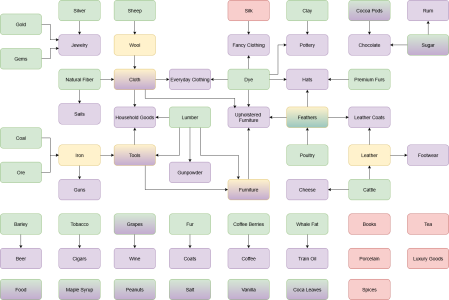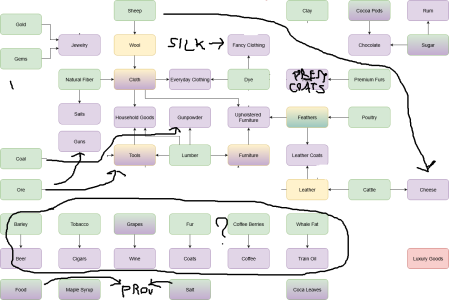1. Reduce overall number of goods so they can fit on two rows instead of three
2. Reduce number of buildings/professions
I think a lot of complaints about complexity is that there are just so many goods, so many professions to keep track of. Sometimes less is more. Especially for new players it is a bit overwhelming to that grid of 99 different goods when opening up the city screen.
3. Combine parallel goods
I consider some goods to be parallel goods if they serve the same design space, but just are found in different climates. The worst offenders are cassava/barley/rice and indigo/logwood/cochineal, but also goods like chickens & geese, or tobacco & yerba, or hemp & flax. I understand the thinking behind wanting to give players access to a broad range of raw and finished goods whether they end up in the Amazon rain forest or the shores of Greenland, but like
@codiac mentioned in his
great comment above, we can treat these goods like fruit that use a single good and a single profession, but have lots of flavorful resources found in diverse corners of the map. There is no need to take up space with goods that simply duplicate each other.
4. Simplify vertical supply chains
This is what I mean by a vertical supply chain:

By and large these supply chains don't interact with any other supply chains, they just add extra steps, each requiring their own building and own professions. Once again, it just seems like extra stuff for its own sake. Take peanuts for example. Do we really need a building and a professional peanut roaster? Have any of us ever paid 5 times as much to have our peanuts professionally roasted? Was there a thriving peanut roasting industry back during colonial times? Did it require a long apprenticeship to learn how to roast peanuts? Not at all. They could have at least gotten creative with it and required salt as an input, but alas, it is just an extra step added for no reason. My proposal treats peanuts, salt, and vanilla as consumable raw goods like maple syrup and coca leaves. Also, like my previous proposal, I knocked out one of the steps from making clothing. It is just too long and doesn't connect with other supply chains which makes it boring.
5. Remove or modify goods that only have one use
6. Add more uses for some goods
One problem with the vertical supply chains above is the creation of intermediate goods that only serve to lengthen the chain. Sure, you could create a new building/profession turning sugar into molasses as an intermediate good before another building/profession turns it into rum, but does that make the game more fun & interesting? I say no. I cut things like peat, charcoal, ropes and other goods that only had a single use. I tried to connect supply chains into more of a web so that goods can be used for different things. In the base mod, the only use for cloth was to turn it into clothes (with colored cloth as a stop along the way). In my proposal cloth can be used for upholstered furniture and for household goods (blankets, curtains, dolls, etc). I just think that adds a more enjoyable kind of complexity instead of tedious complexity.
7. Connect different supply chains for high value goods instead of just adding more steps to a vertical supply chain silo
8. Add goods that can only be purchased overseas to enhance triangle trade and balance out excess gold supplies
Related to the above point I made the most expensive and valuable goods have supply chains that connect to lots of different goods instead of one vertical chain. Household goods and upholstered furniture have the most robust and interconnected supply chains. Not only does this simulate the many different inputs that go into making complex items like this, it also intentionally makes them harder to produce domestically. The defining spirit of this time in history is the emerging globalized economy. The triangle trade shouldn't just be a neat feature, it should be a central part of the game. The whole purpose for having these colonies in the new world was to extract raw resources to be sent back to the mother country and then turned into manufactured goods. That is such a powerful force at the time I've always found it so discouraging that the game incentivizes establishing self-sufficient hermit kingdoms that produce all they need and sell their manufactured goods back to the motherland, the exact opposite of how it should work.
So to that end, I've added additional import only goods: silk, books, tea, and porcelain in addition to changing spices into an import only good and retaining luxury goods. To make fancy clothes now you need silk and dye. To put another barrier in the way of domestic heavy industry I (gasp) added an extra step to make tools (smelting the ore). It struck me as so strange that it required more steps and professions to make pig leather aprons than all the complicated metal goods that resulted in industrialization and mechanization.



